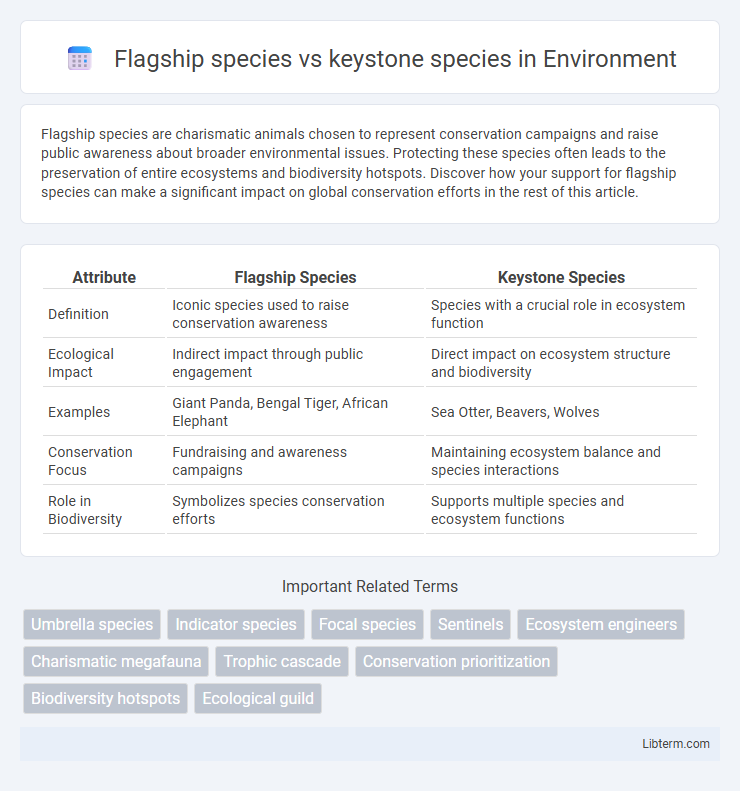Flagship species are charismatic animals chosen to represent conservation campaigns and raise public awareness about broader environmental issues. Protecting these species often leads to the preservation of entire ecosystems and biodiversity hotspots. Discover how your support for flagship species can make a significant impact on global conservation efforts in the rest of this article.
Table of Comparison
| Attribute | Flagship Species | Keystone Species |
|---|---|---|
| Definition | Iconic species used to raise conservation awareness | Species with a crucial role in ecosystem function |
| Ecological Impact | Indirect impact through public engagement | Direct impact on ecosystem structure and biodiversity |
| Examples | Giant Panda, Bengal Tiger, African Elephant | Sea Otter, Beavers, Wolves |
| Conservation Focus | Fundraising and awareness campaigns | Maintaining ecosystem balance and species interactions |
| Role in Biodiversity | Symbolizes species conservation efforts | Supports multiple species and ecosystem functions |
Introduction to Flagship and Keystone Species
Flagship species are iconic animals used to raise public awareness and support for conservation efforts, often representing broader environmental issues. Keystone species play a critical ecological role by maintaining the structure and health of their ecosystems, disproportionately affecting other species and habitat dynamics. Understanding the distinction between these species is essential for targeted conservation strategies and ecosystem management.
Defining Flagship Species
Flagship species are charismatic animals or plants chosen to represent environmental causes, often serving as symbols for conservation campaigns and raising public awareness. These species typically have strong appeal to the general public, which helps garner support and funding for habitat protection and biodiversity preservation. Unlike keystone species, whose ecological roles maintain ecosystem structure, flagship species are primarily used as marketing tools to promote broader conservation goals.
Defining Keystone Species
Keystone species are organisms that have a disproportionately large impact on their ecosystem relative to their abundance, playing a critical role in maintaining ecological balance. Their presence or absence significantly influences the diversity and population structure of other species within the habitat. Unlike flagship species, keystone species may not be well-known but are essential for ecosystem health and function.
Key Differences Between Flagship and Keystone Species
Flagship species are chosen for their appeal and ability to attract public support for conservation efforts, often symbolizing broader environmental causes, whereas keystone species have a disproportionately large impact on ecosystem structure and function relative to their abundance. Flagship species usually garner funding and awareness through their charismatic traits, while keystone species maintain ecological balance by regulating populations of other species and supporting biodiversity. The key difference lies in flagship species driving conservation through public engagement, while keystone species are critical for maintaining ecosystem health and stability.
Ecological Roles and Impacts
Flagship species are iconic animals used primarily for conservation awareness and fundraising due to their cultural or aesthetic appeal, whereas keystone species have a disproportionately large impact on their ecosystems by maintaining the structure and balance of ecological communities. Keystone species regulate populations of other species, promote biodiversity, and influence habitat conditions critical for ecosystem functioning, while flagship species may not play significant ecological roles but serve as symbols to rally public and political support for conservation efforts. Understanding the distinct ecological impacts of keystone species versus the strategic conservation role of flagship species is crucial for targeted environmental management and biodiversity preservation.
Examples of Flagship Species
Iconic examples of flagship species include the Bengal tiger, African elephant, and giant panda, each symbolizing conservation efforts within their respective habitats due to their cultural and ecological significance. These species attract public attention and funding crucial for habitat preservation, unlike keystone species whose impact is defined by their ecological role, such as beavers and sea otters. Flagship species campaigns harness the charisma and appeal of these animals to drive broader environmental protection initiatives.
Examples of Keystone Species
Keystone species play a critical role in maintaining the structure and balance of an ecosystem by regulating population dynamics and promoting biodiversity, with examples including the sea otter (Enhydra lutris), which controls sea urchin populations and protects kelp forests, the gray wolf (Canis lupus), known for its impact on trophic cascades in Yellowstone National Park, and the African elephant (Loxodonta africana), which shapes savanna ecosystems by modifying vegetation and creating habitats for other species. Unlike flagship species that primarily serve as symbols for conservation efforts, keystone species have a direct ecological impact essential for ecosystem stability. Identifying and protecting keystone species is vital for effective ecosystem management and biodiversity preservation.
Conservation Strategies for Flagship vs Keystone Species
Flagship species, chosen for their strong appeal to the public, drive conservation campaigns by raising awareness and funding, often serving as symbols to protect broader ecosystems. Keystone species play a critical ecological role, maintaining the structure and function of habitats, so conservation strategies prioritize preserving their populations to sustain biodiversity and ecosystem stability. Effective conservation combines flagship species' public engagement with targeted ecological interventions centered on keystone species to ensure comprehensive ecosystem protection.
Importance in Biodiversity and Ecosystem Health
Flagship species, such as the giant panda, serve as charismatic symbols that promote conservation awareness and funding, indirectly supporting biodiversity preservation. Keystone species like sea otters play a critical ecological role by maintaining ecosystem structure and function, directly influencing species diversity and habitat health. Protecting both flagship and keystone species is essential for sustaining ecosystem resilience and overall biodiversity stability.
Challenges and Opportunities in Species Conservation
Flagship species often attract public attention and funding, but prioritizing them can overshadow less charismatic keystone species that play critical ecological roles, creating challenges in balanced conservation efforts. Keystone species conservation offers the opportunity to maintain ecosystem stability and biodiversity, yet their subtle presence and ecological functions make them harder to identify and protect effectively. Integrating flagship appeal with keystone ecological importance can enhance strategic conservation planning, ensuring both species survival and ecosystem health.
Flagship species Infographic

 libterm.com
libterm.com